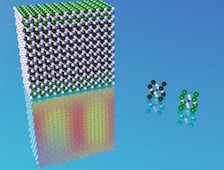Negative capacitance in multidomain ferroelectric superlattices

The stability of spontaneous electrical polarization in ferroelectrics is fundamental to many of their current applications, which range from the simple electric cigarette lighter to non-volatile random access memories1. Research on nanoscale ferroelectrics reveals that their behaviour is profoundly different from that in bulk ferroelectrics, which could lead to new phenomena with potential for future devices. As ferroelectrics become thinner, maintaining a stable polarization becomes increasingly challenging. On the other hand, intentionally destabilizing this polarization can cause the effective electric permittivity of a ferroelectric to become negative5, enabling it to behave as a negative capacitance when integrated in a heterostructure. Negative capacitance has been proposed as a way of overcoming fundamental limitations on the power consumption of field-effect transistors. However, experimental demonstrations of this phenomenon remain contentious. The prevalent interpretations based on homogeneous polarization models are difficult to reconcile with the expected strong tendency for domain formation, but the effect of domains on negative capacitance has received little attention. Here we report negative capacitance in a model system of multidomain ferroelectric–dielectric superlattices across a wide range of temperatures, in both the ferroelectric and paraelectric phases. Using a phenomenological model, we show that domain-wall motion not only gives rise to negative permittivity, but can also enhance, rather than limit, its temperature range. Our first-principles-based atomistic simulations provide detailed microscopic insight into the origin of this phenomenon, identifying the dominant contribution of near-interface layers and paving the way for its future exploitation.
Pavlo Zubko, Jacek C. Wojdeł, Marios Hadjimichael, Stéphanie Fernandez-Pena, Anaïs Sené, Igor Luk’yanchuk, Jean-Marc Triscone & Jorge Íñiguez
Nature volume 534, pages 524–528 (2016)